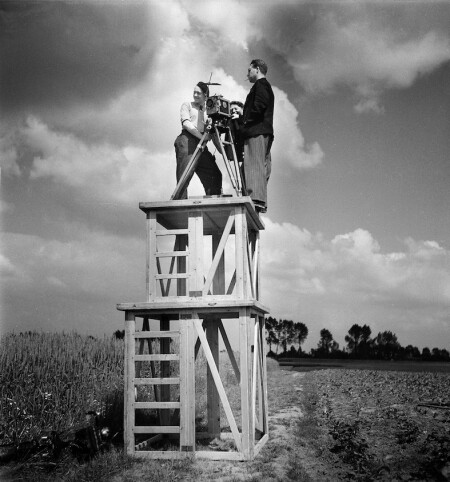Cinema Rural: a Belgian and European directory of moving images of agriculture and rural life
When you think of cinema culture, you might be inclined to imagine vibrant city life, but film has also played a major role in the countryside over the past century. Educational films and documentaries in particular have focused on the farming population in Flanders.
In order to chart and safeguard this agricultural film heritage, and ensure that researchers and the general public can search for, find and consult relevant content, meemoo is joining forces with Cinema Rural, a project run by CAG (Centre for Agricultural History), which forms part of the international initiative by the European Rural History Film Association.
Challenge
CAG wants to trace as much film heritage on the topic of agriculture and rural life in our country as possible, and make it findable. Initially via the cagnet.be knowledge database, and then also for an international audience via the database of the European Rural History Film Association, ERHF-Online-Portal. This international database provides an overview of European agricultural heritage and refers visitors to institutions or databases where they can find more information or look up content. Other aspects of the project include the digitisation of a selection of films and raising awareness among partners around the issues of storage and digitisation.

Recordings ‘de Boerensymfonie’ (‘the Peasant Symphony’) © Henri Storck
The majority of agricultural films in Belgium are saved by CINEMATEK, KADOC (Documentation and Research Centre on Religion Culture and Society from KU Leuven) and a number of other meemoo content partners, including AMSAB-ISG (Institute for Social History), Huis van Alijn (Museum of Daily Life), MOT (Museum for Old Techniques) and Bokrijk Open Air Museum. These films are described (at least minimally) and some of them have already been digitised. CAG wants to gather these collections in a comprehensive database, and add collections that have been stored elsewhere. The quality of the descriptions is also being improved where possible, before being passed on to the EHRF database.
Approach
Phase 1
CAG’s existing database is a central element in the project. In order to be able to make an inventory and record registrations, it needed to be expanded in a sustainable way with a component for describing film content. This ensured that data from various relevant Belgian collection managers could be imported, and that data can be shared from the database.
As well as designing the data model itself, we also developed the tools required for introducing and exchanging data, i.e. an import and export script.
Phase 2
The data model that was developed was then effectively implemented in CAG’s Collective Access database. A URI scheme was also designed; this determines the composition of the website address that’s assigned as a unique identifier for both the films and the copies in the various collections. The metadata for these films and copies can be linked to these unique identifiers. LIBIS, the service provider that provides database management support to CAG, imported the collected data and set up an Open Archives Initiative (OAI) endpoint. This is an access point where relevant heritage organisations and other data users can retrieve free metadata in an automated way.
Phase 3
The last phase of the project (from October 2020) will run pilot projects to implement a link from the CAG database to the heritage institutions’ management systems where the films and/or metadata are stored, e.g. at CINEMATEK and meemoo. Metadata will be published under a CC0 licence. A REST endpoint will also be set up so heritage organisations can retrieve data and write it to the CAG database. If desired, the writing aspect can even be automated via synchronisation, so that all additions of new metadata by individual heritage organisations automatically flow through to the central database. The CAG database is in turn linked to the ERHF database.
At the end of the project, the results will be shared via events and publications.
Meemoo's role
Together with CAG, we developed a data model that matches their CollectiveAccess database and the import and export scripts. Standard exporting of data takes place in the EBUCore format, which enables data to be shared with agricultural film collection managers so they can enrich their own collection inventories. We supervised the implementation of the elements developed in CollectiveAccess, and designed the aforementioned URI scheme for the CAG database. Meemoo collaborated on all of this with:
Sven Lefèvre, researcher affiliated with CAG, who travelled the length of the country to make an inventory of farming films;
Diantha Osseweijer, CAG employee who configured CollectiveAccess;
Valérie Adriaens and Anita Ruijmen from LIBIS who helped us with the import and export scripts and the OAI endpoint.
In the last phase of the project, we’ll be helping to monitor the links between databases and the exchanging of data in pilot projects. We will also be publishing the technical documentation on CEST and contributing to raising awareness of the results via events.
Results
There are currently 551 films described in the CAG film database which can be searched by date, place of production, director, producer, subject, genre, sponsor, client and language.
Meemoo has also completed a number of deliverables and prepared them for publication on CEST:
the configuration file for CollectiveAccess, which allows other organisations to set up the same database and link it to the CAG database;
the import and export scripts, which allow organisations to add and retrieve metadata;
the example file in the EBUCore standard format, which allows the automated exchange of metadata.
Partners
National partners: Boerenbond, CINEMATEK, Department of Agriculture and Fisheries, ILVO, KADOC-KU Leuven, meemoo, VRT (Flemish Radio and Television Broadcasting Organisation) and LIBIS.
International partners: Archives of Rural History, Fryske Akademy, Fries Film Archief, Gesellschaft für Agrargeschichte, Institute of Rural History, Museum of English Rural Life and Université Lumière Lyon-I.
The majority of international partners belong to the European Rural History Film Association.
